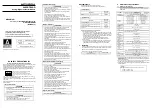
1-30
1
1
CAUTION
(1) When linking the outdoor units in a network, disconnect the terminal extended from the short plug from
all outdoor units except any one of the outdoor units.
(When shipping: In shorted condition.)
For a system without link (no wiring connection between outdoor units), do not remove the short plug.
(2) Do not install the inter-unit control wiring in a way that forms a loop. (Fig. 1-1)
Outdoor unit
Outdoor unit
Outdoor unit
Indoor unit
Indoor unit
Indoor unit
Indoor unit
Prohibited
Prohibited
Indoor unit
Fig. 1-1
(3) Do not install inter-unit control wiring such as star branch wiring. Star branch wiring causes mis-address
setting. (Fig. 1-2)
Fig. 1-2
(4) If branching the inter-unit control wiring, the number of branch points should be 16 or fewer.
Central Controller
Outdoor unit
Outdoor unit
Indoor unit
Indoor unit
Indoor unit
Indoor unit
Indoor unit
Indoor unit
Indoor unit
Indoor unit
Indoor unit
Outdoor unit
: Branch point
More than 2m required
Fig. 1-3
Outdoor unit
Indoor unit
Indoor unit
Indoor unit
Indoor unit
NO
Branch point
(5) Use shielded wires for inter-unit control wiring (c) and
ground the shield on both sides, otherwise misoperation
from noise may occur. (Fig. 1-4)
Connect wiring as shown in Section “Wiring System
Diagrams”.
(6) Connecting cable between indoor unit and outdoor unit shall be approved polychloroprene sheathed 5
or 3 *1.5 mm
2
flexible cord. Type designation 60245 IEC 57 (H05RN-F, GP85PCP etc.) or heavier cord.
Use the standard power supply cables for Europe (such as H05RN-F or H07RN-F which conform to
CENELEC (HAR) rating specifications) or use the cables based on IEC standard. (60245 IEC57, 60245
IEC66)
Fig. 1-4
Loose wiring may cause the terminal to overheat or result in unit malfunction.
A fire hazard may also occur. Therefore, ensure that all wiring is tightly connected.
When connecting each power wire to the terminal, follow the instructions on “How to connect wiring to the terminal” and
fasten the wire securely with the terminal screw.
Shielded wire
SG
SG
WARNING
Stranded wire
Ring
pressure
terminal
Screw and
Special washer
Ring
pressure
terminal
Terminal board
Ring pressure
terminal
Screw
Special
washer
Wire
Wire
Insulation tape
8 mm
Insulation tape
Shield mesh
Shield mesh
Strip 10 mm
Fig. 1-5
Fig. 1-6
Fig. 1-7
Fig. 1-8
Fig. 1-9
Fig. 1-10
How to connect wiring to the terminal
For stranded wiring
(1) Cut the wire end with cutting pliers,
then strip the insulation to expose
the stranded wiring about 10 mm and
tightly twist the wire ends. (Fig. 1-5)
(2) Using a Phillips head screwdriver,
remove the terminal screw(s) on the
terminal board.
(3) Using a ring connector fastener or
pliers, securely clamp each stripped
wire end with a ring pressure terminal.
(4) Place the ring pressure terminal,
and replace and tighten the removed
terminal screw using a screwdriver.
(Fig. 1-6)
Examples of shield wires
(1) Remove cable coat not to scratch braided shield. (Fig. 1-7)
(2) Unbraid the braided shield carefully and twist the
unbraided shield wires tightly together. Insulate the shield
wires by covering them with an insulation tube or wrapping
insulation tape around them. (Fig. 1-8)
(3) Remove coat of signal wire. (Fig. 1-9)
(4) Attach ring pressure terminals to the signal wires and the
shield wires insulated in Step (2). (Fig. 1-10)
SM830252-01_欧州_Single_8・10HP_TD_SM.indb 30
16/10/14 13:57:13
AMP Air Conditioning
www.ampair.co.uk | [email protected]
















































